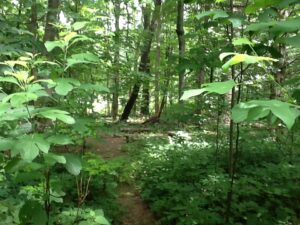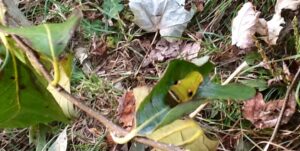By Wren Smith
Sassafras (Sassafras albidum)
 Sassafras (Sassafras albidum) has three distinctively different leaves: leaves shaped like spoons, mittens and three-fingered gloves, all on one tree. Look around and you’ll see this small tree and others in this area – some that are a good deal larger. The root bark of sassafras has an odor of root beer, and was used in many early root beer recipes. I’ve enjoyed a tea from these roots in my youth, but today the FDA cautions against ingesting it, due to a carcinogen known as safrole.
Sassafras (Sassafras albidum) has three distinctively different leaves: leaves shaped like spoons, mittens and three-fingered gloves, all on one tree. Look around and you’ll see this small tree and others in this area – some that are a good deal larger. The root bark of sassafras has an odor of root beer, and was used in many early root beer recipes. I’ve enjoyed a tea from these roots in my youth, but today the FDA cautions against ingesting it, due to a carcinogen known as safrole.
If you gently bruise the leaves of sassafras, you will enjoy a lemon-lime fragrance. Adding water to those leaves and rubbing them together quickly will create a mucilaginous slime that illustrates its former role as a thickening agent in Cajun cooking, such as gumbo.

Sassafras and spicebush trees are the important host plants of the spicebush butterfly caterpillars who feed on their leaves.

As Joe mentions in his video, mulberry leaves look a little similar. However, the leaves of mulberry are toothy (serrated margins) and rough to the touch. Notice the sassafras on your left and the mulberry in the right of the photo below.
Questions to Ponder at Bernheim
How do the butterflies know to lay their eggs on sassafras?
What do sassafras leaves or twigs smell like to you?
Additional Resources
Colorful History of Sassafras, Pocono Record

